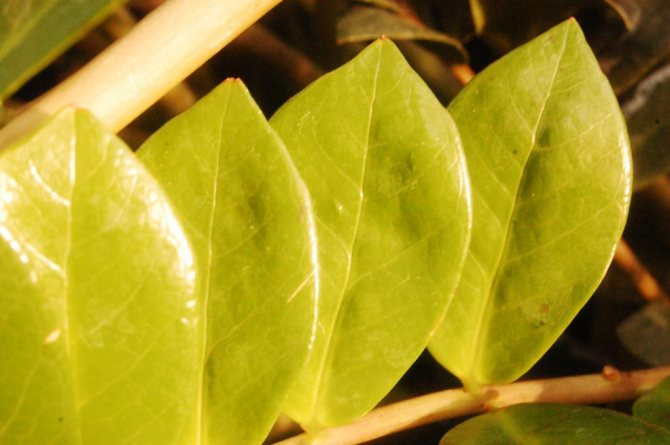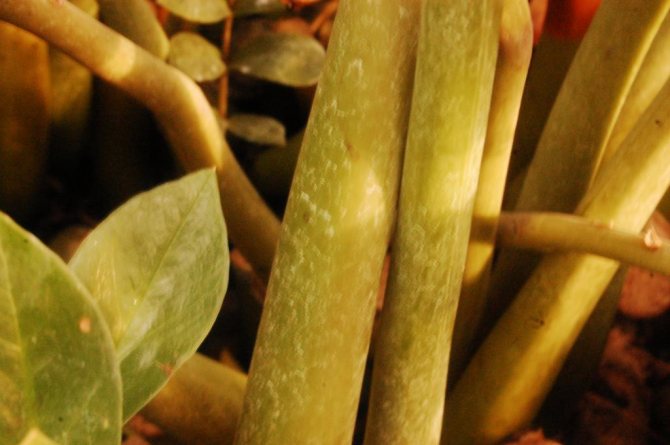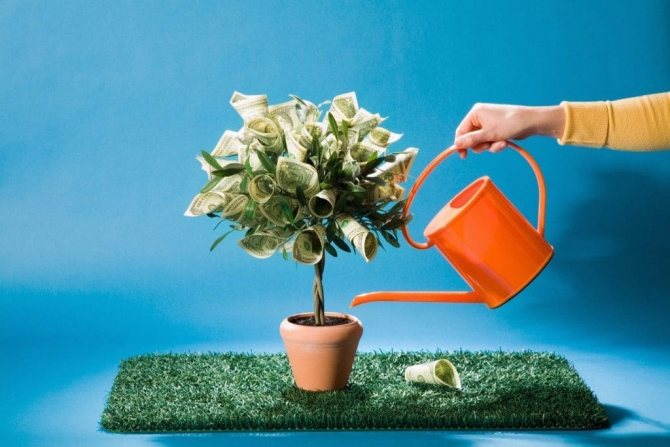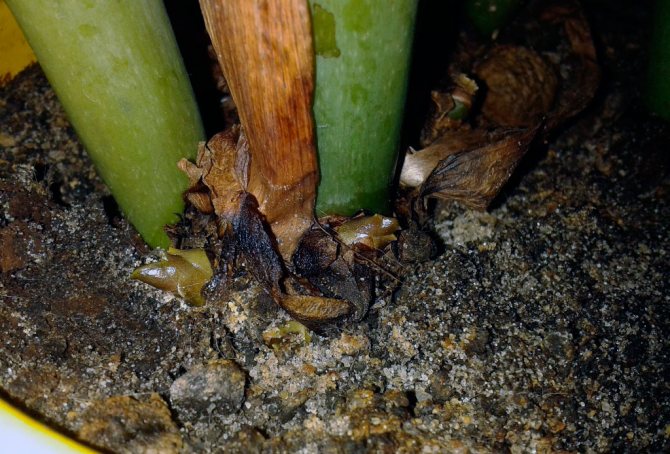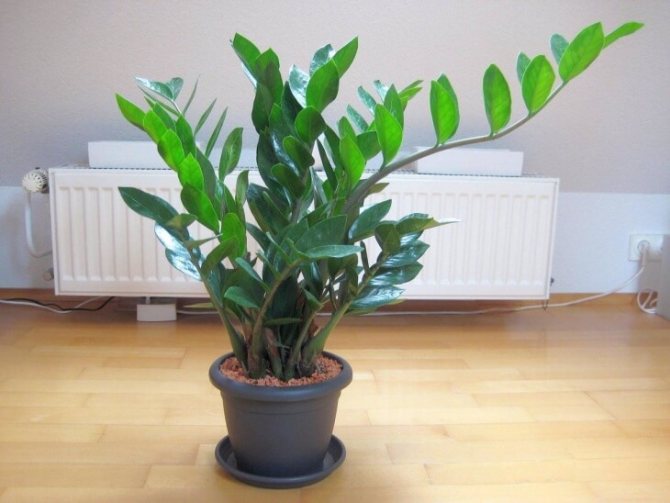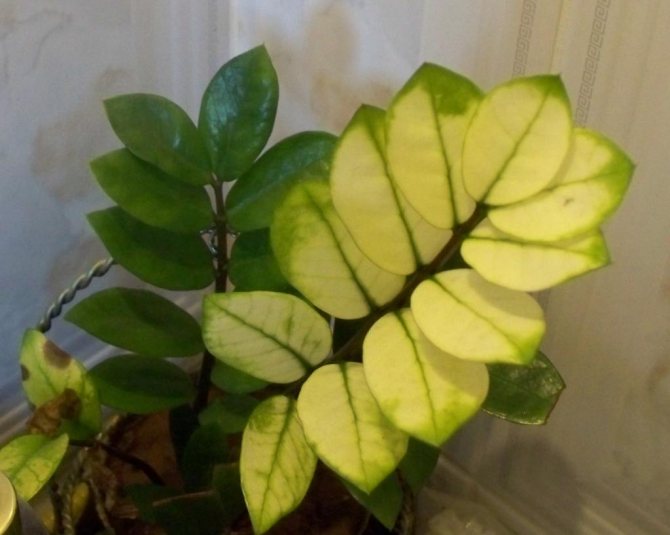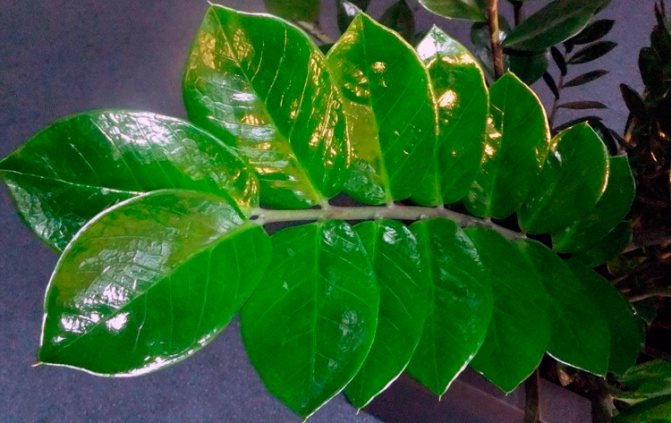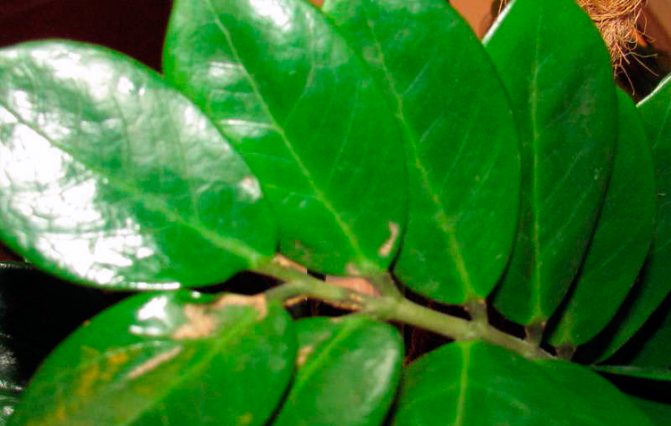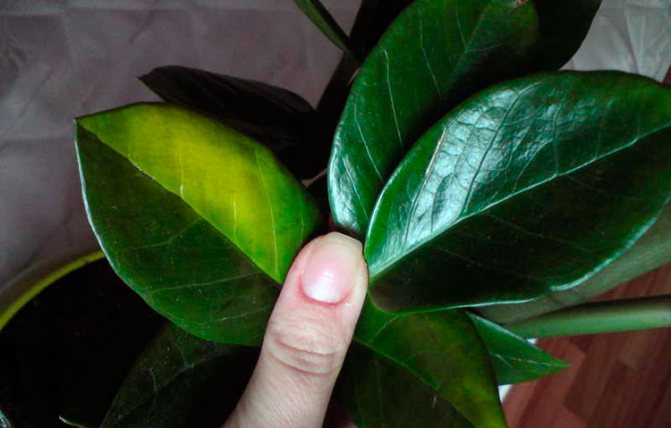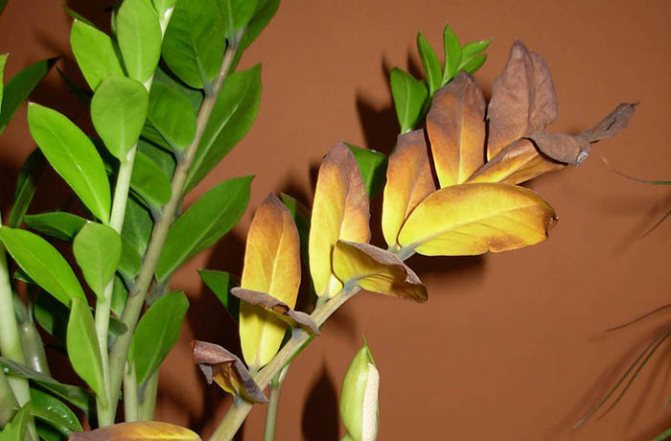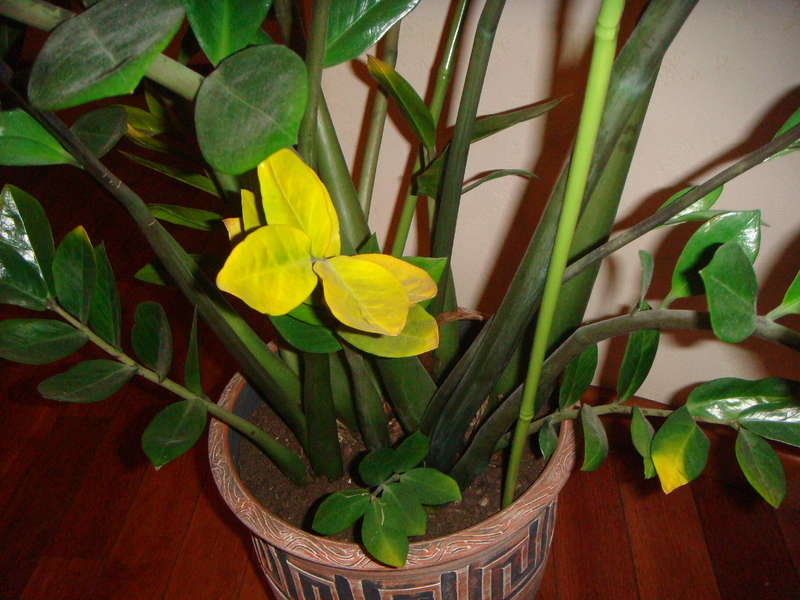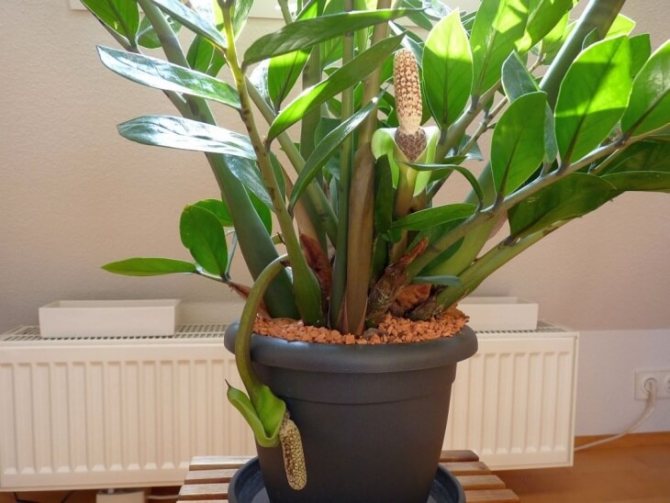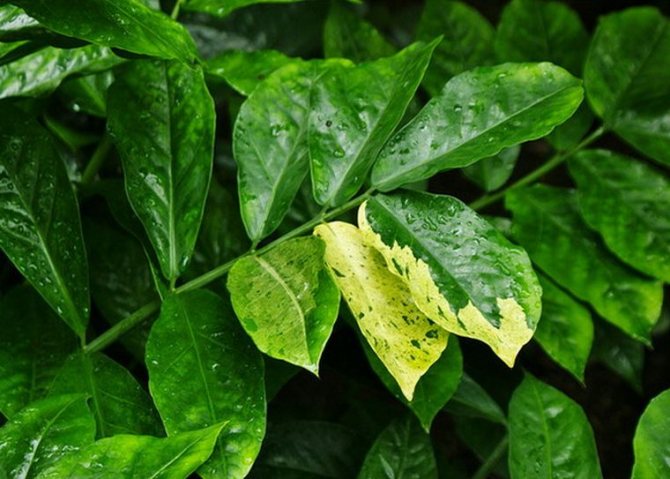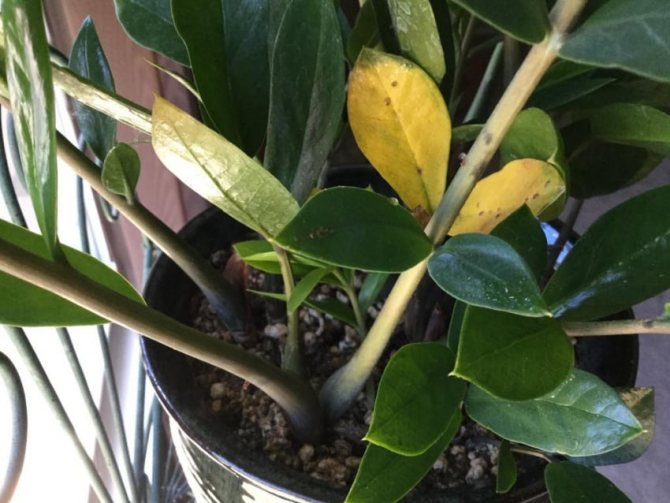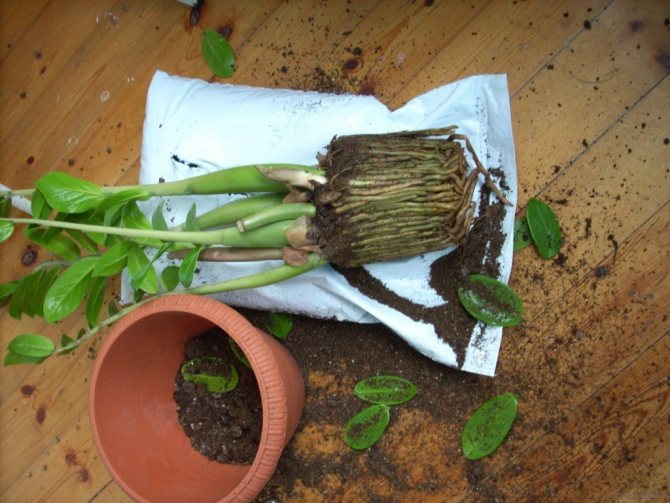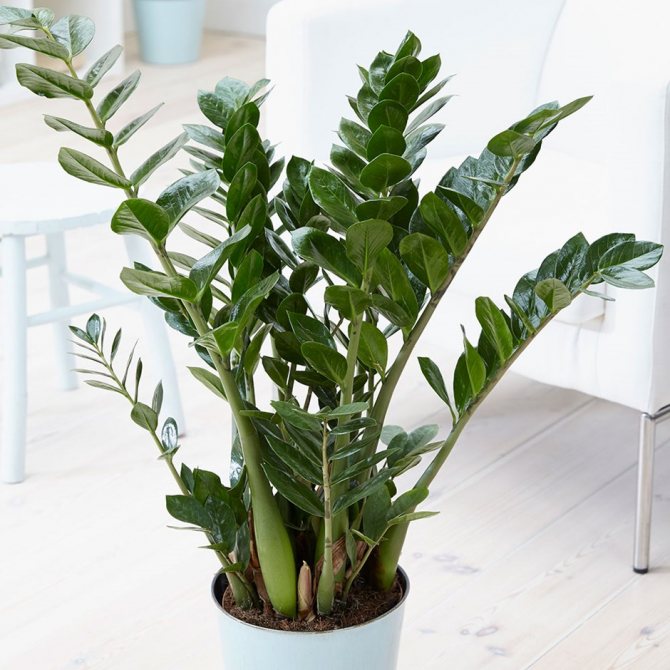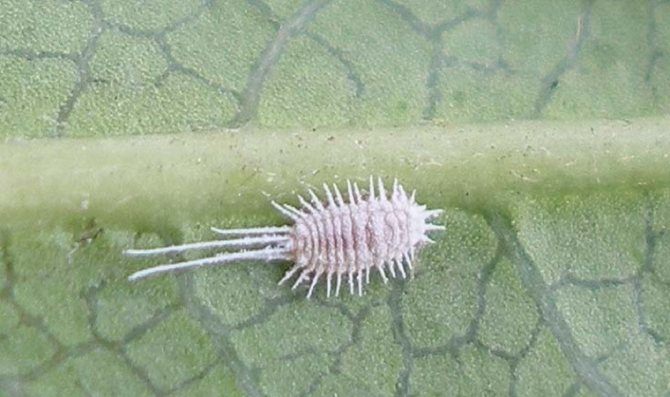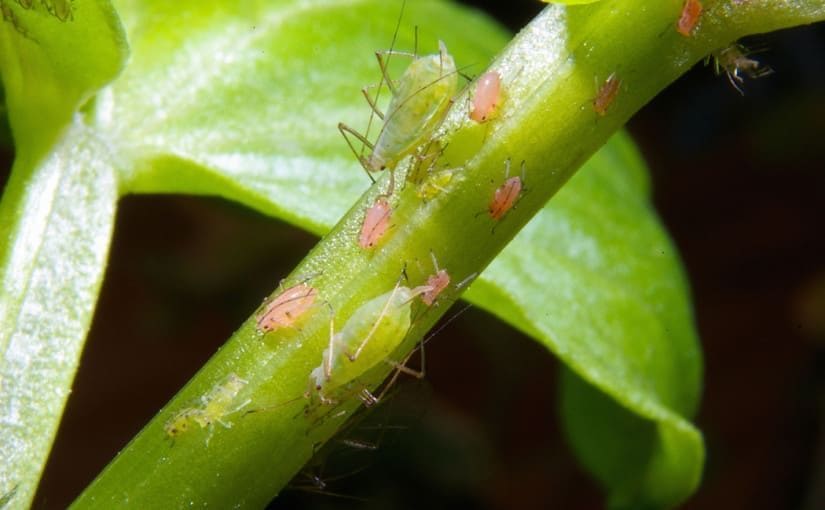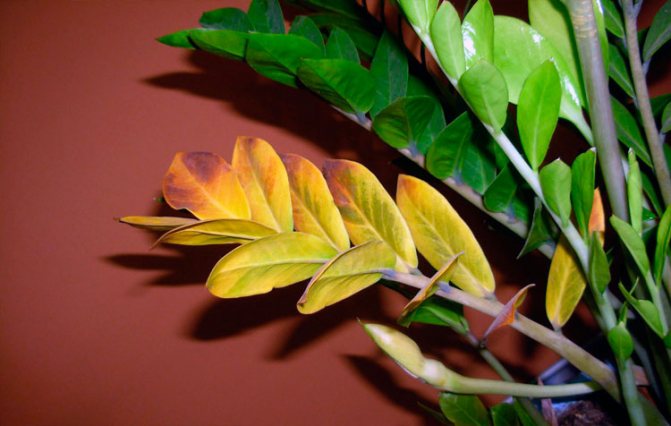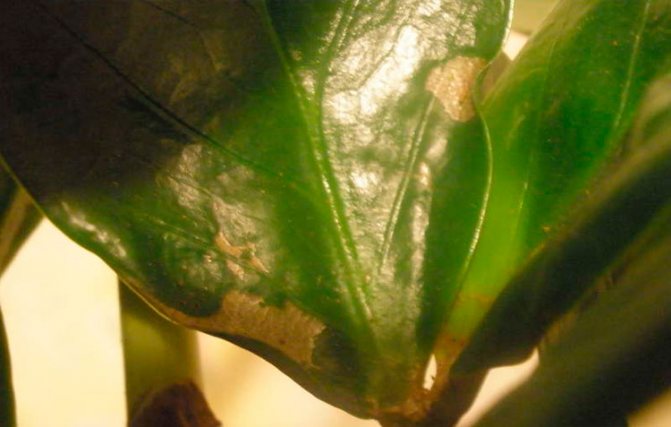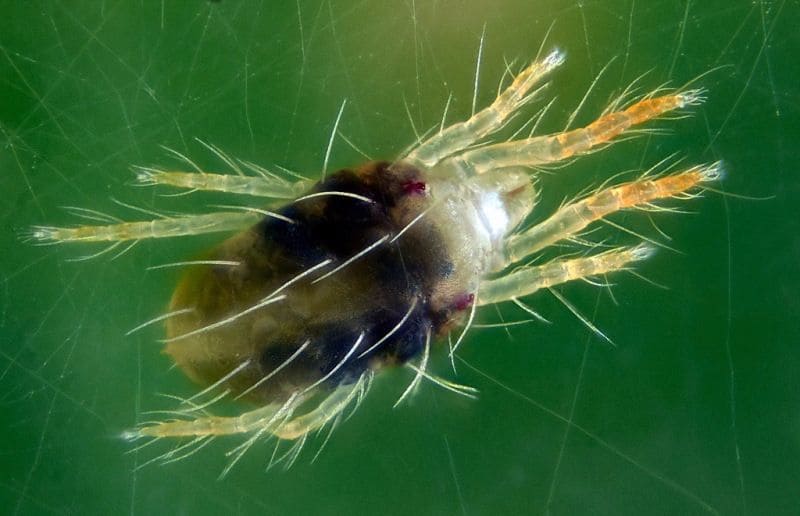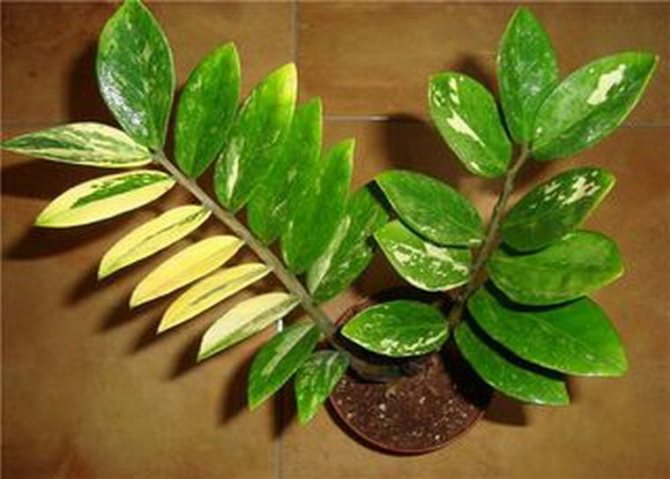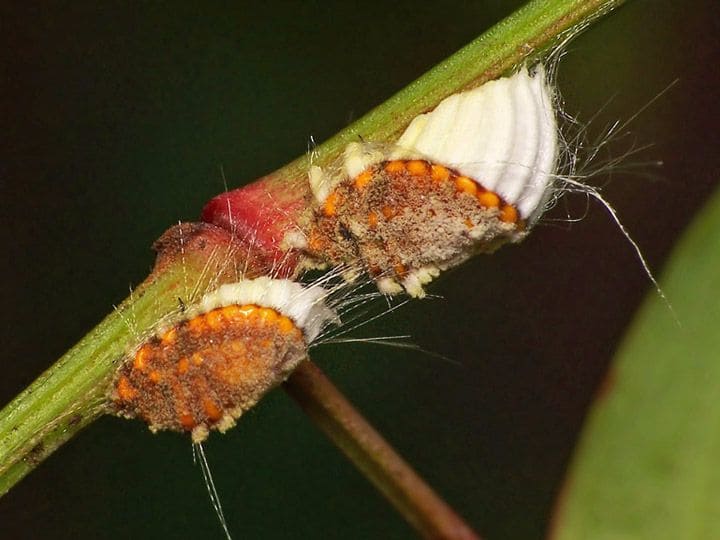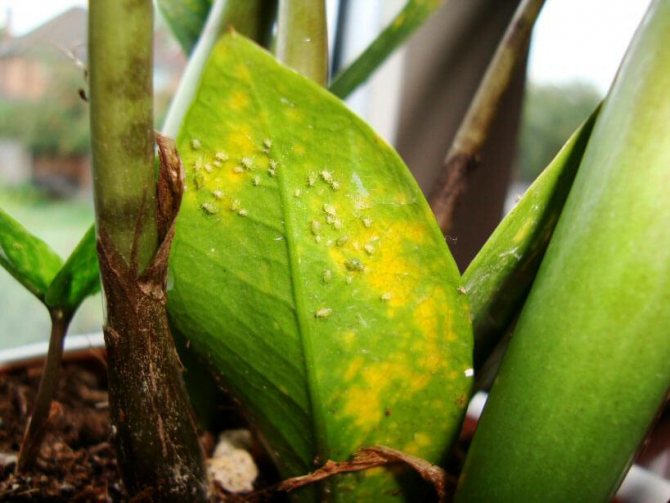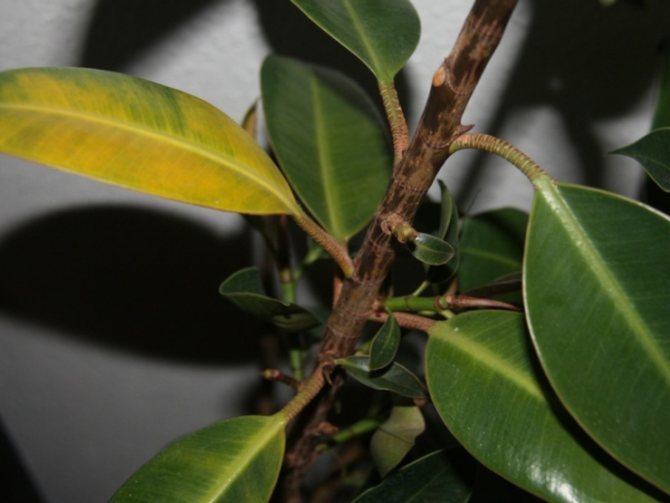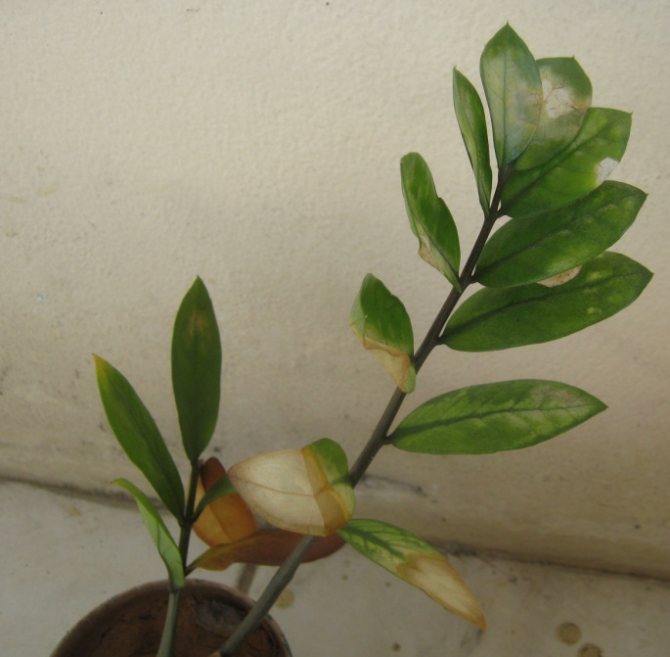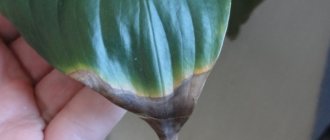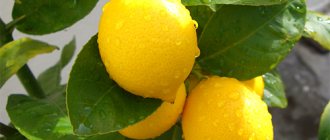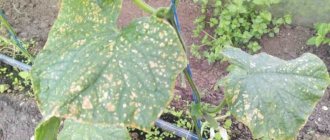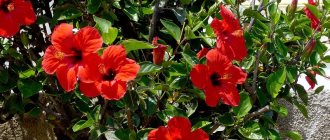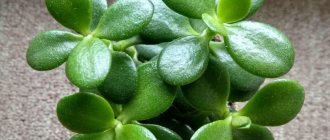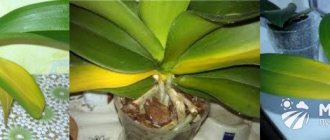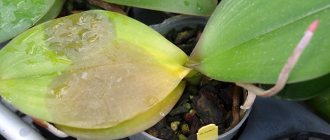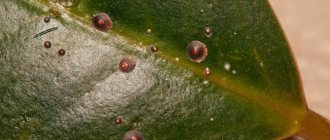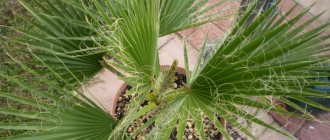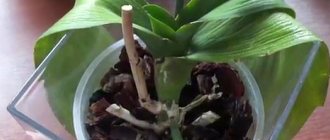The tropical African plant zamiokulkas, we also call it the dollar tree, is an exotic home decoration. True, it is not quite easy to find it in our area. But still, you can find a way and revive your collection with a decorative item.
Glossy dark green leaves on the edges of the stems growing directly from the bulb form a kind of hanging meter garlands, and the pale cream flowers on the cobs of the leaves give this plant even more elegance.
Only this is a rare phenomenon, and not everyone has seen the flowers of the dollar tree. The unconventional shape of flowers with a volumetric pattern, reminiscent of a crackle of valuable antiques in a light green-green wrapper, is like an offering in gratitude to its caring owner. The plant brings harmony and understanding to the house, and judging by its name - and the American currency.
But sometimes it happens that the holiday of life is somewhat darkened when the zamioculcas is unhappy with a lack of attention, and expresses this with yellowed leaves.
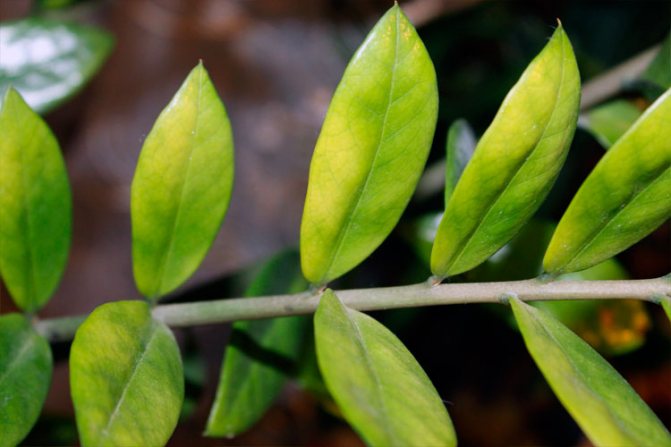
Why do the leaves of the money tree turn yellow
There can be many reasons why the leaves of zamiokulkas turn yellow. The foliage turns yellow, as a rule, according to the natural cycle of the life of the culture or due to the actions of the grower. In any case, you never need to jump to conclusions. First, it is worth determining the nature of yellowing, analyzing the care, remembering that, like any other plants, zamiokulkas also replaces foliage from time to time.
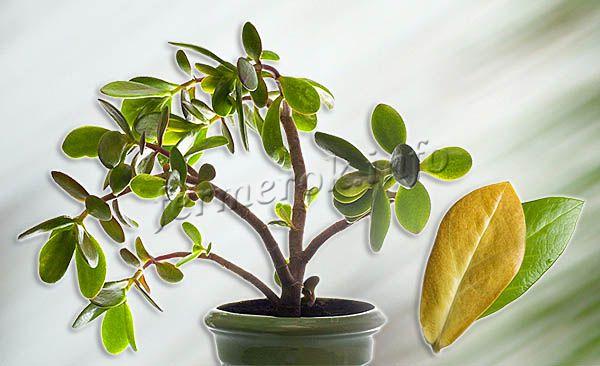

First, you should determine the nature of yellowing.
In a short period of time, yellow leaves will not destroy the culture. This is only the first signal that notifies of the problem, and not the last, so there is always time to solve a strange symptom, the main thing is not to delay it.
How to transplant a dollar tree at home into another pot?
In zamiokulkas, the root system is a dense structure of tubers. They are vulnerable. If you carry out a careless transplant and do not water, the roots can be damaged, therefore it is advisable to carry out this operation carefully. This process is carried out according to the following description:
- A pot suitable for overgrown roots is selected.
- Drainage and the acquired earthen mixture are laid at the bottom.
- Zamioculcas, simultaneously with a lump of earth, is removed from the old pot and transferred to a new one.
- The rest is covered with earth in such an amount that the roots remain bare by a centimeter.
Transplanting and caring for the dollar tree should be carried out with gloves, since the zamioculcas juice is considered caustic and can cause severe itching and severe burning.
The reasons for the sharp yellowing of leaves in Zamioculcas
Check out these articles as well
- The best eggplant caviar recipes
- Winter rye
- Plum variety Renclode
- Onion variety Hercules
The money tree is unpretentious in care, therefore it is especially surprising when the foliage begins to turn yellow for no particular reason. In this case, the question immediately arises, what to do and why did yellow leaves appear at all? A sharp yellowing of foliage occurs for natural reasons or due to improper care.
Natural yellowing of foliage
This phenomenon is caused by the growth of the plant.Zamioculcas grows rather slowly both in the natural environment and at home. As they grow, new leaves appear, and the old ones, for quite natural reasons, wither, turn yellow and fall off. This is normal for a plant, because the forces go to the development of young foliage, and there are not enough nutrients to maintain the vital activity of old leaves. In this case, there is no need to wonder what to do. You need to take this as a fact and from time to time just remove the fallen leaves in the pot or near it.
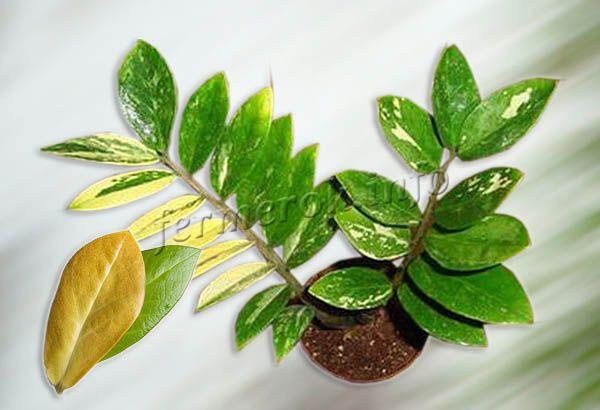

Natural yellowing of foliage
Interesting!
Some varieties of zamioculcas have yellow spots on the surface by nature!
It is very easy to understand that the reason is natural. The plant, despite the yellowed leaves, continues to form new leaves, the pagon grows, the color of the majority of the crown is green.
Improper care
Often, improper home care is the cause of a sharp yellowing of zamiokulkas leaves.
- Lighting should be diffused. Culture needs sunlight, but only up to 6 hours a day. If the zamiokulkas stays in the sun for a long time, its leaves will begin to turn yellow, and brown burns will appear. Outdoor airing can be done early in the morning or in the evening when the sun goes down.
- The temperature regime must be maintained at the same level. Cold coming from a window or heat from heating appliances can negatively affect the color of the leaves. Make sure the temperature is about the same every day.
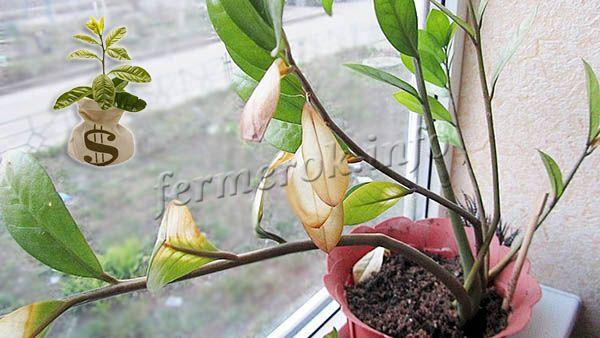

Improper care. Waterlogging of the soil
- Watering is moderate. Under natural conditions, this plant receives quite a lot of water, but without excess. During the period of active growth - from spring to autumn, you need to water the plant quite often so that the earth only slightly dries up, but it never was dry! In winter, watering is minimized.
Important!
If the soil is cracked and begins to lag behind the pot, this is a sign of an acute shortage of water.
- Top dressing is carried out only once a year from spring to autumn. If you overfeed a crop, or over-feed it too often, the crop will simply wither. Initially, the leaves of the zamioculcas turn yellow, but then the root also suffers. In winter, no feeding is carried out at all.
Conditions of existence
The success of growing a dollar tree depends on the observance of some rules:
- Rare watering
- Lots of light
- Light soil
- Temperature regime
- Cramped pot
The homeland of Zamiokulkas is Africa. She determined the nature of the plant. Rare rainfall on this continent forced him to adapt to the accumulation of moisture in all parts of the plant. With an excess of moisture, it rots, starting from the roots and ending with the leaves. When maintaining an emerald tree, you need to follow the principle: less is better than more. This applies to water and fertilizers.
This plant is watered when the earthen coma is completely dry.
If the stick or finger dipped into the soil of the pot to a depth of 4 cm remains dry, then it's time to water. The frequency of watering in the summer depends on the condition of the soil. It dries faster in a small pot. According to the experience of many gardeners, the frequency of watering should be as follows:
- In the summer, once every two weeks
- In winter, once a month
The direction of the flow of sunlight at different times of the year should be different. In summer, the tree reacts well to fresh air. On an open veranda, under a stream of sunlight, it will revive, release new leaves, and possibly bloom. When kept indoors in the summer, it is better to remove the plant from direct sunlight, but not far. During this hot and dry season, sunlight should be diffused.
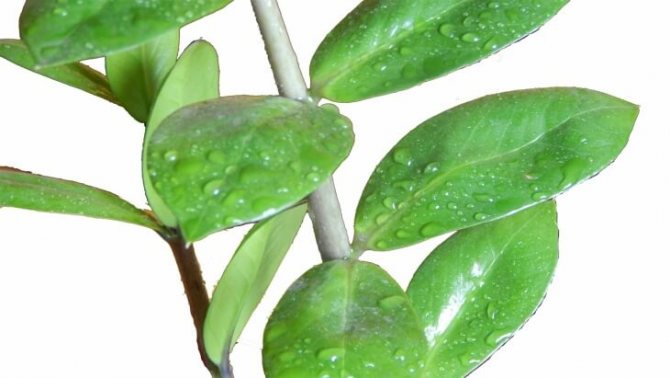

Type of leaves of zamiokulkas
Zamioculcas endures the shadow steadfastly, but it does not give him much joy:
- Growth stops
- No new leaves appear
- The whole plant fades a little
- Flowering is very difficult to achieve
In winter, the flower feels good on the southern windows in direct sunlight. This plant seems to have been created for living in urban apartments with dry air.
The soil mixture for growing the dollar tree should be lightweight, permeable. In garden centers, it is better to purchase packages with such soil, intended for cacti and succulents.
You can prepare the soil for planting yourself. This will require:
- Humus
- Sand
- Leaf land
All these components are thoroughly mixed in equal proportions. Vermiculite can be used instead of sand. It holds moisture well and balances soil moisture. At the bottom of the pot, drainage must be placed, which can take up a quarter of the volume.
Yellowed leaves
The temperature for the content of zamiokulkas depends on the season.
From March to August, the temperature range can range from 18 ° C to 30 ° C. Such a drop is not terrible for the money tree. At temperatures above 30 ° C, it is necessary to protect it from overheating by spraying or wiping the sheet plates with non-cold water.
In September, the temperature should be gradually reduced. The emerald palm tree tolerates the autumn-winter period at a temperature of about 16 ° C. Winter for zamiokulkas is not a period of rest. Some specimens begin to release leaves in the winter.
The planting tank is not spacious or even cramped. The volume of the pot should be such that the roots only fit.
Compliance with all the conditions for the growth of the dollar tree will crown the work of the florist with success and luscious greenery.
What to do to save the plant
Knowing why the leaves on the zamioculcas turn yellow, you can also determine the method for eliminating the problem.
- If the irrigation was not carried out correctly and the soil is too moist, it is necessary to pull the plant out of the wet soil, remove the excess soil that is being picked up by hands, and then check the root system. If there is rot at the root, it is cut off and the cuts are treated with a crushed activated carbon tablet. After that, the culture is planted in a new, dry soil.
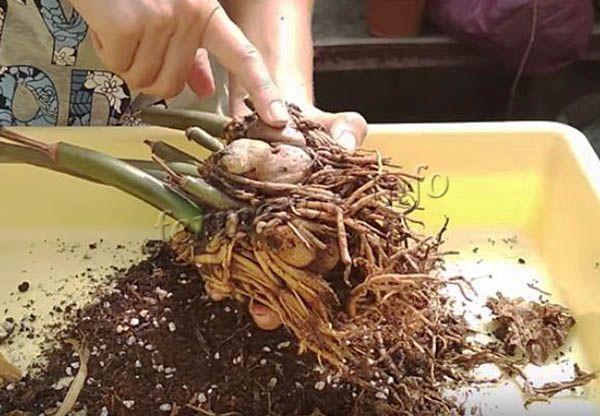

If there is rot at the root, it is cut off
- If watering was not enough, the plant is not enough just to water. The first step is to get the plant and examine the roots. If there are damaged ones, they, as in the first case, are cut off and treated with activated carbon. Now the plant is planted in a new pot with new soil and watered after transplanting. If the humidity is adjusted correctly, then the zamiokulkasa will quickly revive and grow.
- If the reason for the yellowing of the foliage was the wrong light or temperature, then you need to change the place for the pot. But the place is changed gradually so that there are no sharp changes, otherwise the money tree will experience considerable stress.
Important!
When growing zamiokulkas, you need to remember that it is better not to feed the plant than to overfeed. This crop does not need frequent feeding, it grows slowly, and therefore does not consume a lot of nutrients from the ground.
- When a plant has suffered from an abundance of fertilizing, all that can be done is to transplant it into new soil and just wait until it starts to recede. It is not worth adding new fertilizing until the plant completely departs and goes back to growth. Then, no earlier than 6 months later (if the time does not fall for winter), you can add top dressing.
Description of the plant
Zamioculcas is a herb that is commonly called the dollar tree. The leaves are green, but most often a little darkish. The color of young shoots is usually light green.
Zamioculcas is a relative of the monstera, but has recently become more popular than its relative.The dollar tree is an unpretentious plant that can easily live without sunny color and frequent watering, so this plant can be safely placed not only at home, but also in offices.
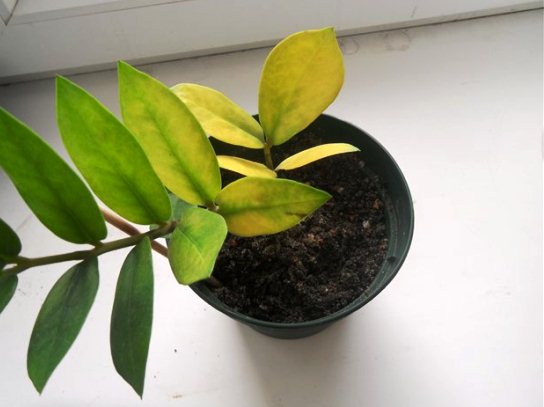

As for flowering, zamioculcas does not very often please its owners with this event. Even with good care, it is very difficult to make it bloom. And you don't need to do this, the flowers of the dollar tree are completely nondescript and you won't want to admire them. This plant is a toxic plant, so don't make it bloom, it may not be very good for your health.
The most common problem is yellowing leaves. Why this process takes place for many remains a mystery.
Now let's try to find out this reason.
Leaves turn yellow after transplanting Zamioculcas
We recommend reading our other articles
- Fodder beet
- The best varieties of dill
- Carrot variety Queen of autumn
- How to plant raspberries in the fall
Sometimes flower growers note that after transplantation, the zamiokulkas begin to turn yellow, and then the leaves begin to fall off. The reason why this happens is that the root was damaged during the extraction of the plant. But this does not mean that the culture will die, it can be saved if you start to immediately respond.
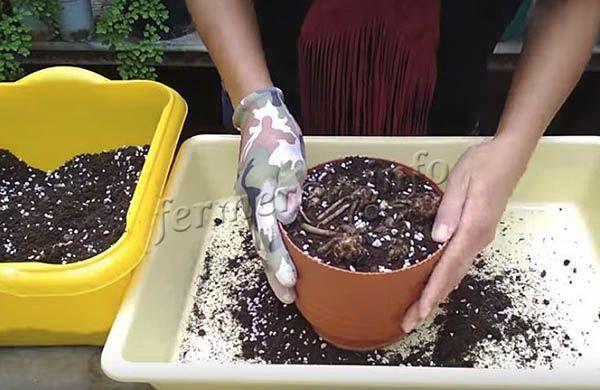

Transplant into a larger pot with soil replacement and complete pruning of the shoots
First of all, the flower is pulled out of the pot, and its root is examined. All damaged areas on the root will be slightly rotten - this is clearly visible. They need to be cut to healthy tissue, and then the cut sites must be treated with activated charcoal to disinfect. After that, the root must dry out so that the upper moisture evaporates. After that, you can plant the plant again, but in new soil.
Interesting!
It happens that when a root is divided, many branches remain on a small root. As a result, the plant does not have enough strength for such a load, and therefore the leaves of the zamiokulkas begin to turn yellow. As soon as the roots increase in volume, the flower will stop turning yellow and will start growing again.
What does a dollar tree look like: photo
If you study the photo, we can conclude that the culture has glossy, bright green leaves. The fleshy leaf contains about ten feathers. If cared for correctly, you can achieve a meter growth. According to its external characteristics, it looks like a money tree. There are some similarities with properties. Also, through the tuberous root, it stores the volume of water that the culture needs.
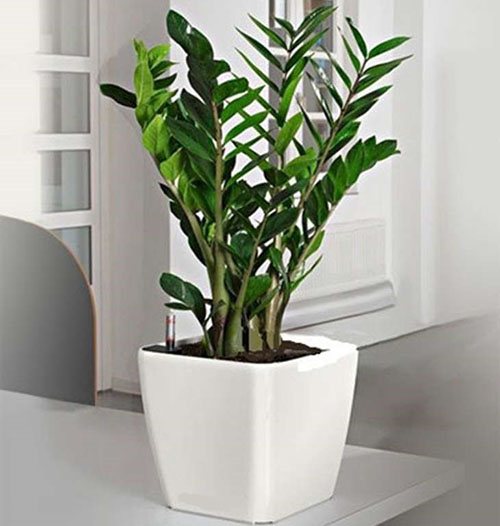

In some photos of the dollar tree, you can see how the plant blooms. This rarely happens. Flowers of white, light yellow or slightly pink color appear, covered with a large leaf on the outside. In order for flowers to appear, it is important to properly care for, provide the following conditions:
- comfortable warm ambient temperature;
- moderate water intake;
- lighting.
Subject to the listed conditions, flowering occurs at a young age.
Pests and their danger
Pests often lead to yellowing of the foliage of the zamiokulkas. What to do if pests appear on the plant? First, you need to determine their nature, type, and then destroy by means of a mechanical method, as well as by spraying with insecticides.
Zamioculcas most often undergoes invasions of aphids, scale insects, and spider mites. When aphids appear on the leaves, dark mucus is visible. The scabbard can be recognized by the dark beetles on the stems and leaves that look like growths. A spider mite is identified by a cobweb on the back of a leaf.
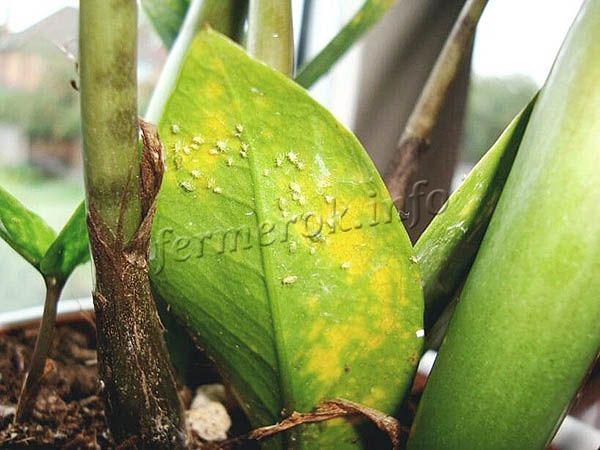

Zamioculcas most often undergoes invasions of aphids, scale insects and spider mites
A soap solution can be used to combat these pests. 30 g of the drug is taken per liter of water. The resulting liquid is treated with the entire ground part of the culture.The second option is a garlic solution (1 chopped head of garlic is taken per liter of water). After the liquid has been infused for 7 days, the plant is sprayed with it. If this remedy did not help, then you can use insecticides like "Aktara", "Aktellik", "Intavir".
How to care?
Each of the listed points related to leaving is worth studying in detail. Providing lighting is very important. During the adaptation period, a semi-dark place is suitable. After a couple of days, the pot is allowed to be transferred to the windowsill, moving it regularly to avoid direct sun.
Growth and flowering are allowed to be obtained while maintaining a temperature regime equal to 25 degrees above zero in the summer. In cold weather, the regime should be 16 degrees.
The humidity level deserves attention. To ensure normal operation, you can perform the following actions:
- it is recommended to spray the leaves with warm water every day. Its temperature should be room temperature;
- you can stop the pot on a special tray in which there is drainage, moss or peat.
It is advisable to wipe the leaves during the heating season. If the room is cool, this procedure should not be carried out. It is equally important to correctly feed zamiokulkas with fertilizers. For this purpose, special feeding should be used.
Tips for growing Zamioculcas
The recommendations below will solve the problem of yellowing of the leaves and help the culture recover faster.
- When processing root sections, you can add a little root formation stimulator to the activated carbon.
- If the leaves gradually turn yellow, and then completely become colorless, this means that the plant has too little light or nutrition. You need to move it to another window, maybe this will help. But if it does not help, you will need to add top dressing.
- If the florist is afraid to use mineral fertilizers, you can make a top dressing for zamiokulkas from humus, egg shells or fresh greens. Infusions on these products are nutritious and no less useful than minerals. Only use them in low concentration!
Zamioculcas is a beautiful culture. If you take care of him correctly, he will never bring special problems, but only attract good luck and financial well-being to the family. If the plant begins to turn yellow, you should not get upset in advance, you need to think about what the reasons may be, solve them, and then the culture will recover very quickly.
How to Water a Dollar Tree: How Often?
The flower does not tolerate the excess amount of moisture. It can be caused by one reason - stagnant water in the sump, high humidity in the room. At the same time, it is strictly forbidden to dry out the earth. This will cause the flower to use up its own water after planting. The error is manifested by yellowed leaves and their fall.
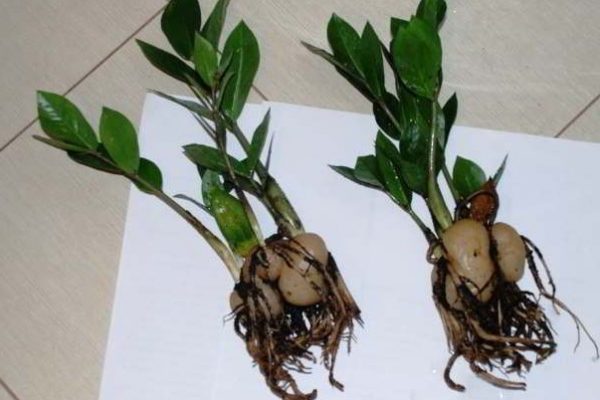

Water for irrigation should be at room temperature. It is important to first boil it or let it stand for a day. If after irrigation water remains in the container, it must be drained. This is the main reason why more plant. This feature will avoid rotting roots and leaves. In winter, the plant should be watered twice less often, if not growing.
To please with beauty and health
In order for the plant to be beautiful and healthy, one should not neglect the very simple rules for keeping zamiokulkas.
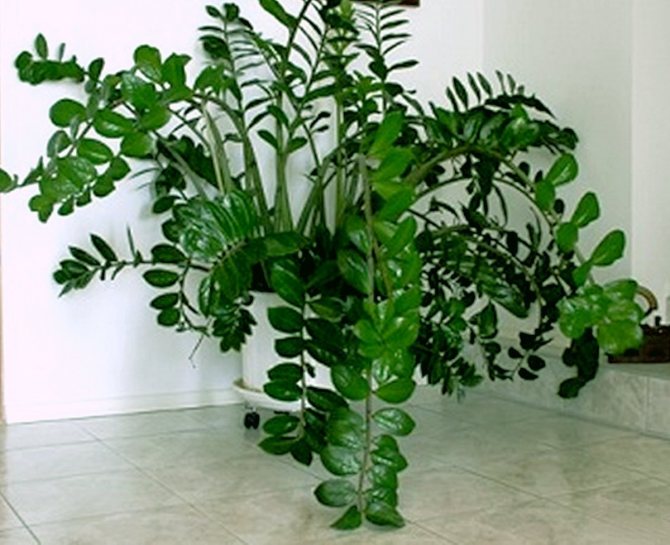

A healthy plant evokes only positive emotions
Shoot growth problems
In order for the zamioculcas to grow greens faster, do not plant it in a spacious pot. The more voluminous the dishes at the flower, the larger the root tuber and the more modest the leaves. The soil for this semi-succulent plant needs porous and poor. Suitable soil for cacti or universal, highly diluted with coarse sand. This flower does not like vermiculite, perlite and sphagnum moss, experts of zamioculcas assure.But high-quality drainage: holes in the pot and a layer of expanded clay at the bottom - he will appreciate it.
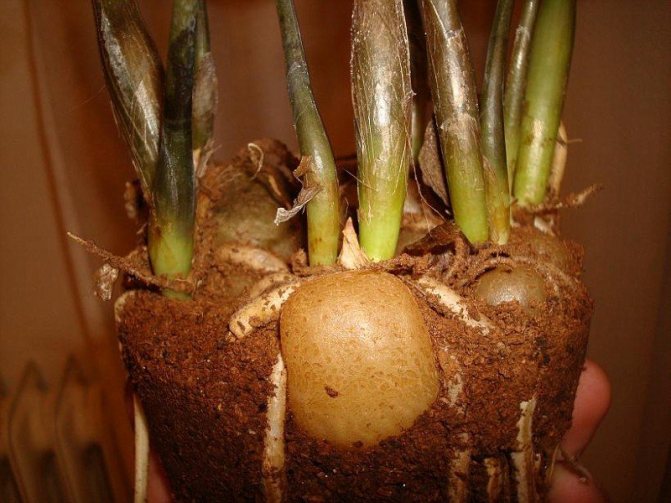

Zamiokulkas tubers store moisture and nutrition in case of drought
Be careful with water: overfilling is worse than underfilling
In summer, please zamioculcas with outdoor vacations, put it on the balcony or in the garden. The African feels great on a sultry afternoon in the sun. It is not necessary to specially humidify the air for it. From water procedures, to help the flower breathe, leave only dusting the foliage and occasionally a warm shower. When swimming, be sure to cover the soil with waterproof material to avoid waterlogging. It is important not to be too zealous with watering, the zamiokulkas will even be glad if they sometimes forget to drink it. Wait until the soil is completely dry, wait another 3-4 days and only then water. But know the limit and with moderation: with prolonged drought, foliage will begin to fall. True, it is not difficult to remedy the situation: if the root is alive, just add water.
Whether watering is necessary, it is convenient to check with a thin wooden skewer. It must be carefully inserted at the edge of the pot to the very bottom, then turned around the axis and pulled out. If wet earth stuck to the skewer, then it is too early to water.
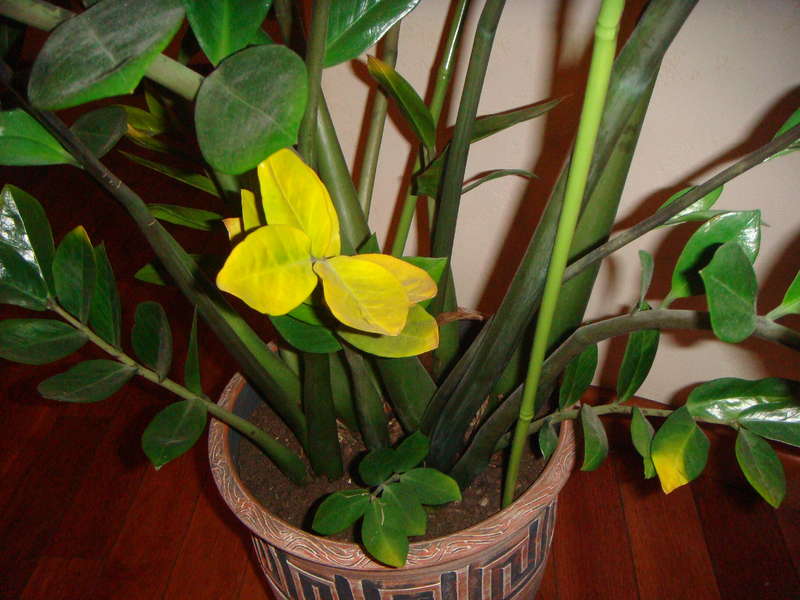

Zamioculcas is afraid of waterlogged soil
But waterlogging of the soil is a sure way to serious problems and diseases: especially difficult, when excess moisture is combined with low temperatures and a lack of lighting. This combination can destroy the main part of the plant - the root, not to mention the yellowing and blackening branches.
Table: they do not allow to grow and develop - diseases and pests
| Diseases | Pests |
| Root rot (tuber) | Spider mite |
| Stem rot | Aphid |
| Chlorosis | Mealybug |
| Fomoz | Shield |
| Mottling | Mushroom gnat (midge) |
| Black | Podura |
For the health of stems and roots - disease prevention
Very often, flower growers say that they looked after zamiokulkas according to the rules, but the plant still got sick or was attacked by pests. The reason is the lack of reasonable prevention. Pathogens or parasites can enter the flower pot if safety precautions are not followed. Phytosanitary control operates at the borders of states. It should be at the entrance to every apartment.
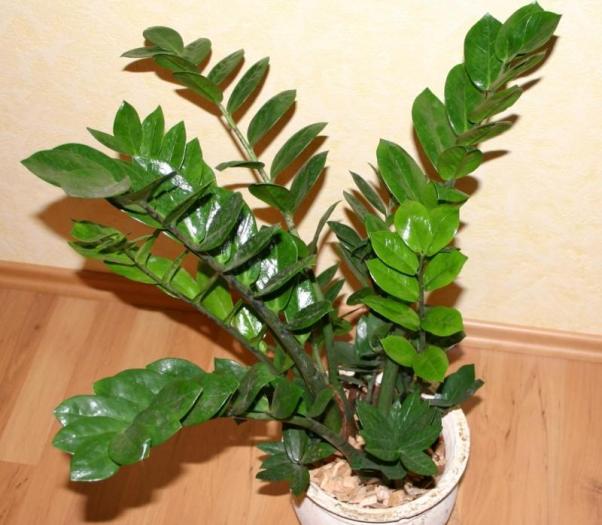

To keep the plants healthy, follow the rules of care and transplantation.
How to ensure plant safety:
- carry out "control at the entrance". When planning to bring home a new plant, whether from a store or elsewhere, make sure it is not infected with disease or parasites. Examine the stems, and if possible the roots, for visible symptoms: spots, dots, other damage. Inspect zamioculcas for pests. A barely noticeable white speck may be a mealybug, and a brown one is a scabbard. It is better to discard the plant with signs of the disease. Such an acquisition will be more of a hassle than a pleasure;
- quarantine for beginners is a must! In your opinion, the plant is perfectly healthy - don't trust the first impression. Problems can appear over time. Don't put the newbie right in with the rest of the colors. Keep it isolated for two weeks, or better for a month. And only after quarantine, introduce the new plant to your neighbors on the windowsill;
- sterility is a guarantee of health. Be careful when replanting zamioculcas. Most bacteria, fungi and parasites spread through the soil. Before planting, disinfect the substrate (including the store one) by calcining, frying in the microwave, and pour over the pot with boiling water. You can also water the new soil with a solution of Fitosporin (other fungicides) or manganese, then dry it.
Video: how to grow a healthy dollar tree
Natural causes
Aging is an irreversible process during which old leaves die off and new leaves are formed.
Due to physiological characteristics, no more than 17 leaf lobes can be simultaneously located on adult shoots of zamiokulkas - later on, the vegetative processes are lengthened and the plates are replaced by productive ones.
If in a plant single lower segments acquire a yellow tint and the formation of a petiole is observed, you should not worry, these are obvious symptoms of renewal.
Drafts
This succulent is very sensitive to drastic climate changes and drafts. Failure to comply with the optimum temperature will lead to the fact that the leaves begin to change color evenly over the entire surface. If frequent drafts are to blame, then yellowing will only be observed from one side. It is on this basis that it will be possible to draw a conclusion about the cause of the plant disease.
What to do in this case? Move to a quieter location. Do not open windows if the flower is on the windowsill. Additionally, you can provide the plant with nutrition in the form of adding humus or special fertilizers for succulents.
Natural aging
Zamioculcas is so attractive outwardly that many are trying to get it for themselves. At the same time, almost no one knows one interesting feature of this plant. One handle can have no more than 17 plates at a time. Therefore, as the young leaf lobes grow, the old ones gradually turn yellow and die off.
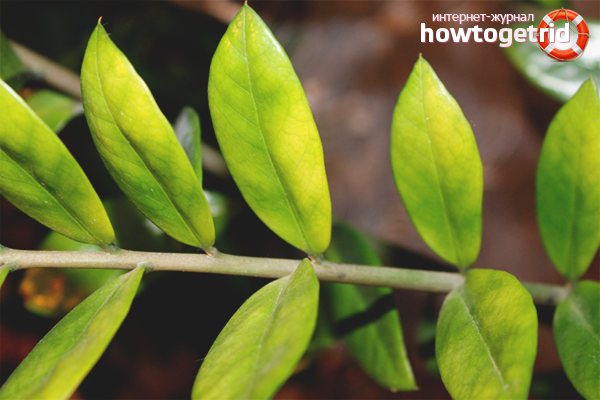

Naturally, over time, the zamioculcas loses its beauty a little. The lower parts of the petioles are bare, and at the top a neat fan of leaf plates is obtained. But do not rack your brains about the loss of decorativeness, for this comrade is growing very slowly.
Signs.
One, two lower plates of the leaf turn yellow. New shoots appear.
What to do.
Nothing. Buy yourself a present for taking good care of your pet. Does he grow and develop according to the norm, does he not express his dissatisfaction? It means that you are doing everything right.
Reproduction methods
Zamioculcas can be propagated in several ways:
- sheet plates;
- separate leaves.
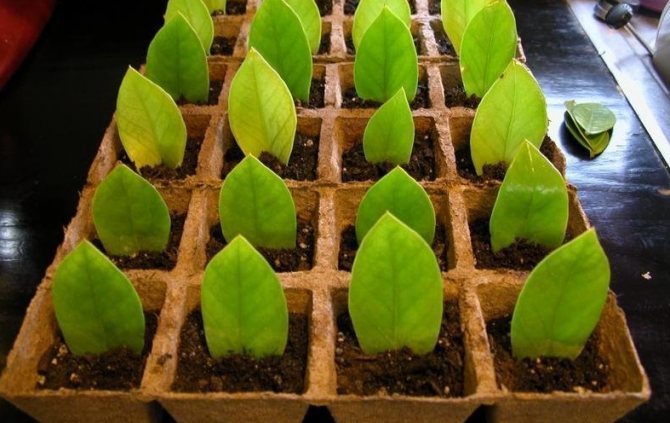

Plate propagation
For reproduction of the plant, you should choose a well-developed middle-aged leaf plate and carefully divide it into several cuttings so that each of them has several leaves.
After dividing the leaf plate into cuttings, they must be left in the air for several hours.
The end of each branch is necessarily treated with activated carbon. This will help stimulate root growth. Also, for these purposes, you can use purchased products - Zircon or Kornevin.
For growing cuttings, use a light soil with the addition of vermiculite, which will make the soil looser.
To speed up the rooting process of cuttings, they can be covered with glass or foil.
For the first time, the sprouts will need to be watered only three days after planting. This should be done carefully: slightly sprinkling the soil from the sprayer.
Within approximately 1-1.5 months, tubers with roots will appear on the cuttings. In the next 5 months, the first leaves will begin to develop on young plants.
After the root system grows well and the leaves get stronger, young plants can be transplanted into a new pot.
Propagation by leaves
This method involves separating several individual leaves from the sheet plate. The leaves should be outdoors for several hours. This is necessary so that the cut site is completely dry.
On the underside, the leaves must be treated with a root development stimulant.
In order for the leaves to take root, they are laid out on a moist substrate consisting of equal parts of sand and peat. Glass or plastic is placed on the pot to create a greenhouse effect.
Before the first shoots appear, it is not recommended to ventilate the room.
You can plant leaves without a greenhouse. For these purposes, use the usual soil for zamiokulkas, in which the treated leaves are carefully placed. Two days after planting, the soil must be carefully moistened.
After about a month, you will be able to notice the first tubers, on which roots will begin to form.
The plant can also be propagated with the help of individual leaves in water. The main thing is to treat the cut site with means to stimulate root formation.
One of the most popular indoor plants
Zamioculcas (Zamioculcas) is an evergreen representative of the exotic flora, belongs to the Aroid family. This species has no varieties. Zamioculcas is a tuberous herb. Complex odd-pinnate leaves, having the correct shape, form a kind of rosette. The leaf plate is dark green with a strong gloss. The height of a houseplant is usually no more than one meter. Flowers have no aesthetic value.
Under natural conditions, zamioculcas is found in East Africa. The presence of a powerful tuberous root allows you to store a large amount of moisture. Due to its resistance to drought and the scorching sun, it is able to grow in desert areas. Therefore, indoors, the flower is unpretentious and takes root well in indoor conditions. However, in an enclosed space (however, as in nature), it blooms extremely rarely.
Description of the flower Zamioculcas (Zamioculcas)
The dollar tree grows very slowly. A plant transplant is required if the pot is completely filled with the root system. The optimal time for its implementation is the beginning of spring.
For planting zamiokulkas choose a high pot (preferably ceramic), so that the roots and tubers have enough space. The container should not be too large, otherwise the plant will waste energy on filling it with the root system and stop vegetative growth. There must be at least one drainage hole in the bottom of the pot.
The soil substrate is purchased in a specialized store or prepared independently. The ideal soil composition includes sand, peat and turf in equal proportions.
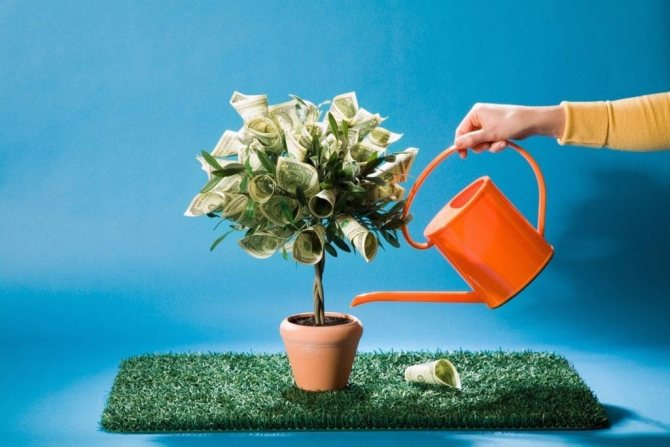

The transplant is carried out by the transshipment method in this way:
- A drainage layer of expanded clay (4 cm) and a small layer of soil (3-5 cm) are laid on the bottom of the pot.
- Carefully remove the plant from the old pot along with an earthen lump.
- Zamioculcas with part of the old soil is placed in a prepared container on a new moistened substrate. The root tubers should be as close to the surface as possible.
- The free space between the flower and the edge of the pot is covered with soil.
- Watering is not carried out during the first week after transplanting.
Reproduction of zamiokulkas is carried out by dividing the tubers and rooting the leaves. It is almost impossible to propagate a plant by seeds, moreover, they are rarely found on the free market. And the seeds collected from home zamiokulkas, as a rule, cannot be called high-quality planting material.
Tubers
Most often, growers use the tuber breeding method. It is considered to be the simplest and most effective one. To propagate a dollar tree with tubers, you must adhere to the following instructions:
- The roots of the flower are removed from the pot and cleaned of the earth.
- Make a neat division of the root system. If necessary, cut the tubers with a sharp knife.
- Sections are treated with a 2% fungicide solution. Activated carbon is crushed and a fresh cut is sprinkled with the resulting powder.
- Parts of the treated tubers are dried in the open air for 24 hours.
- Plants are planted in the ground. Watering is temporarily replaced by spraying.
- The pot is placed in a warm place with a temperature of about 25 ° C.
Often, a young growth of zamiokulkas is formed in a pot.During transplantation, in most cases, it is easy to separate it from the mother tuber and plant it in a separate pot.
Leafy cuttings
A less common breeding option for zamiokulkas is with the help of leaf cuttings. For this, the following procedure is carried out:
- With the help of a sharp knife, a healthy leaf is cut, the cut must be done at an angle. You can root the entire complex leaf as a whole, or you can root small leaves separately.
- The section is dried in air for 24 hours.
- Mix the drug Kornevin and activated carbon powder. The resulting mixture is treated with a cut, a stalk or leaf is pressed into moist soil.
- Create a greenhouse environment. To do this, cover the pot with a handle with glass or foil. It is important to maintain a constant temperature around 22 ° C.
- It is important to provide daily spraying and ventilation for ten minutes before roots emerge.
- Within three months, a root system should appear in the form of small tubers, which will give new shoots.
- Young dollar trees are transplanted in individual containers, following the usual planting rules.
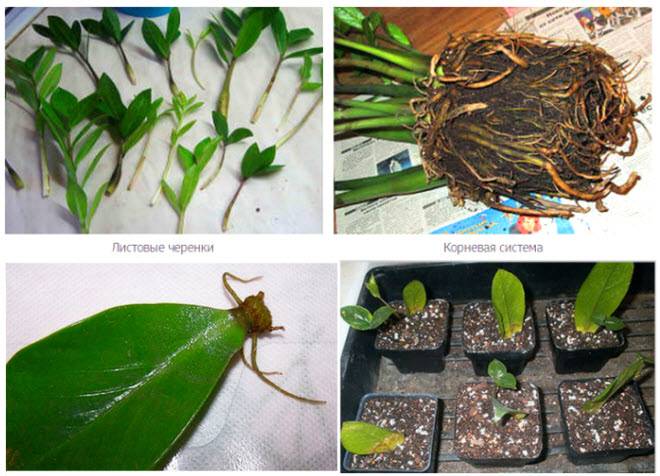

Young specimens are transplanted once every two years. You don't need to take large pots. If the root is free, then the plant stops growing and does not start growing until the roots fill the entire pot. And a pot that is too large will allow the water to stagnate, leading to root rot.
Do a zamioculcus transplant at home without injuring the root system, since the roots are very sensitive to transplantation. Therefore, many growers recommend using a plastic pot so that you can cut it if the tubers cannot be easily removed from the old container.
Usually, the transplant is done in the spring or summer. But if you just bought a plant, then you need to transplant in 2 weeks, so that the plant gets used to a new place, to light and temperature. And then it is necessary to transplant. The soil and pot in which these indoor flowers are sold are not intended for a long life, but are only suitable for sale.
It is better to buy land ready for the aroids. And when planting, loosen it to become fluffy. But if there is none, then the usual soil must be loosened with sand, sphagnum or expanded clay. The additive should be no more than 1/3 of the total volume of the soil. The soil should be peat-free or with minimal peat content.
Drainage. This is very important for zamiokulkus, let's not forget that in nature water simply goes deep into the depths, and this process needs to be organized in a pot.
When transplanting into a new pot, make sure that the plant is planted as deep as it was planted in the old pot.
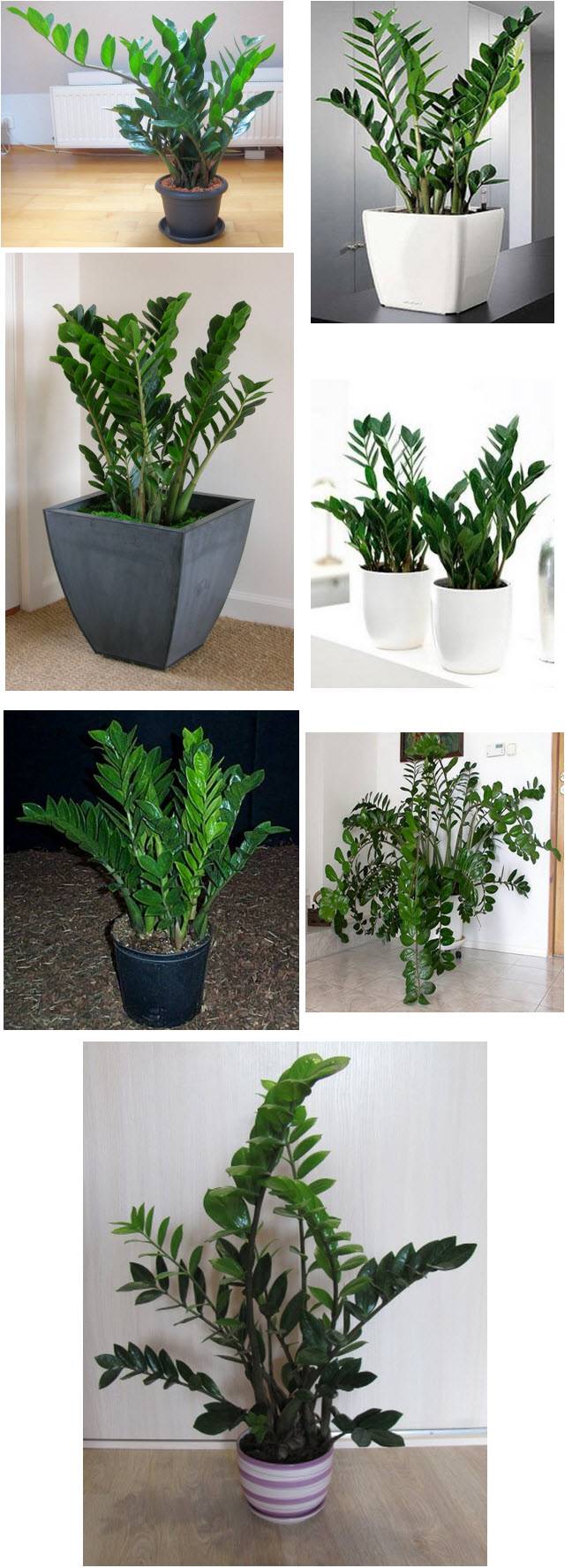

Watch the video how a specialist, phytodesigner Sergey Lipatov makes a transplant
By dividing the tuber
When transplanting, you can see the daughter's small nodules on a large tuber.
Zamioculcas divides itself as it grows, and creates planting material itself. It is necessary to carefully separate the nodule from the daughter, trying not to harm the root much. After that, it is best to wind the damaged tubers a little, let them lie down and dry for a couple of hours, then sprinkle with charcoal (or activated carbon) and only after these procedures, plant them in pots. This must be done to prevent the decay process from starting. On the nodule, the daughter must have a sprout.
It is impossible to cut the tuber itself for reproduction, you need to take only independently detached nodules.
It is impossible to deepen during planting, to deepen as much as the main tuber. With such a planting, it is difficult for the plant to maintain an upright position, put a support. Or choose another breeding method.
By dividing the cutting
The leaf of the "dollar tree" is complex. On which is called - rachis - green "leaf blades" grow. You can propagate as part of this large complex leaf. That is, part of the rachis with leaf plates.


Some florists are advised to place a cut of the cuttings in water to form roots. (I wouldn't do that, but there are precedents). For this, a cut is made with a sharp knife or blade. Then it is placed in water with charcoal or activated carbon and installed on the windowsill. It is advisable to take great care to keep the water clean. After the roots appear, plant in a pot.
Basically, flower growers recommend preparing the stalk, treating the cut with charcoal, drying it for several hours and immediately planting it in the ground mixed in half with sand. Cover the stalk with a glass jar.
This greenhouse must be opened periodically to ventilate the sprout. And water around the perimeter of the pot so that water does not fall on the handle. Rooting stimulants can be used.
When planting, make sure that there is a place with a bud under the ground, that is, the place from which the leaf plate grows.
The leaf should also be treated with charcoal, as well as the cutting, and dried. This is necessary so that a crust forms at the site of damage, preventing the flow of plant sap.
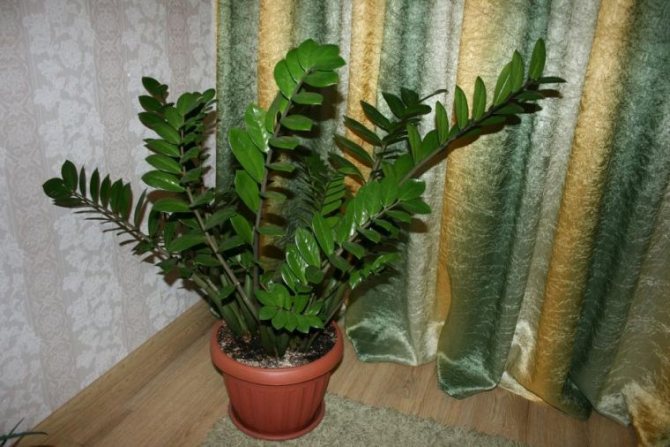

Then the leaf is dropped into the soil, which is half sand, and covered with a jar. This is a kind of greenhouse. It will take a lot of time to form a nodule, from 2 months to six months. Don't break the fit, be patient.
The Zamioculcas flower belongs to the aroid family. He came to us from tropical Africa. Among people, due to its beautiful green leaves, the plant was called the dollar tree. In its properties, it is similar to the money tree. So the flower accumulates moisture inside the trunk, leaves and roots and then uses it as needed. This allows him to survive in the dry period typical of his homeland.
The leaves of the dollar tree are very beautiful and fleshy. On average, 10 feathers are part of one leaf. The root of the flower is tuberous. It is he who stores in himself most of the water that the plant needs during difficult periods of drought. The height of the tree is 1 meter. Unlike the money tree, this plant can bloom. True, this event occurs extremely rarely, even in the wild. It is almost impossible to wait for flowering at home.
The most important advantage of this indoor plant is its ease of maintenance. Due to its bright appearance and high growth, the dollar tree is well suited for decorating large rooms. In small rooms, this flower can also blend harmoniously, if the rooms are not overloaded with other flowers.
The plant needs an annual transplant. The most suitable period for this is spring. The soil must be nutritious enough. The best composition: sod land, peat, sand, leafy soil. Good humus is an excellent fertilizer. Adults in this group require a more rare transplant - once every two years. When choosing a pot, you need to consider the size of the root system. They must be proportionate.
Reproduction can occur by leaf, cuttings or bush. Planting shoots is not difficult at all:
- The leaf is dried before planting;
- When planting a leaf or cutting, it is worth using soil with phytohormones, which will allow them to root faster;
- The rooting process can take two months.
Diseases: Treatment and Prevention
The most common cause of malaise of zamiokulkas is waterlogging of the soil. Because of this, the plant is affected by various types of rot. But there are also diseases associated with mechanical injuries, metabolism. They weaken the immune system. And as a result, all the same rot appears.
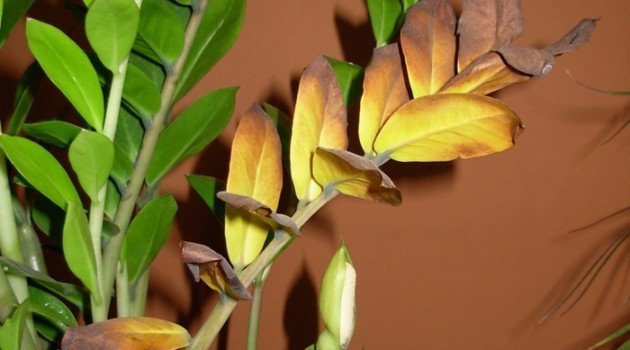

This zamioculcas needs diagnosis and urgent treatment.
Injuries are the cause of many problems
Zamioculcas injuries: a broken branch, frostbite, scratches and tears are not terrible in themselves, but can lead to serious illness, becoming a gateway for infections. If the wounds are left untreated, the plant can become infected. Be sure to disinfect the injured area. You can sprinkle with activated charcoal, sulfur powder, cinnamon (it is a good antiseptic), grease with brilliant green and dry. While healing, the wound will be covered with a layer of dry dead cells, and then healed.
If you accidentally break off a healthy zamiokulkas leaf, it can be rooted. Cut it off above the break point and place it in the water. Roots with a small tuber are soon formed. Then plant the plant in a small pot with light soil.
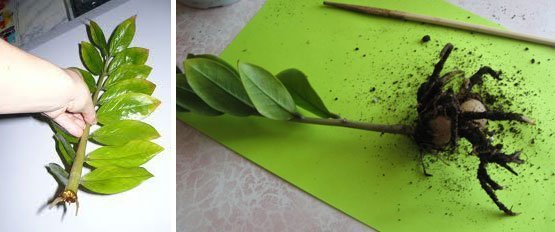

A new plant can be grown from an accidentally broken off leaf of zamiokulkas
Metabolic diseases
These diseases are not infectious, but associated with care errors. The most common are chlorosis, etiolation (light deficiency), deficiency or excess of macro- and microelements.
- chlorosis is a violation of the process of photosynthesis. Zamiokulkas leaves discolor, turn yellow, white spots appear on them. Treat the plant with Fitoverm several times at intervals of 3-4 days. Feed him. For prevention, spraying with iron chelate (Antichlorosin) can be used. Some growers advise to bury a rusty nail in the ground to provide it with iron;
- etiolation is a disease caused by a lack of light. Zamioculcas prefers bright light, but also tolerates shading. This patience should not be overused. If there is not enough light for the plant, the leaves are ugly stretched, discolored, the leaf segments become smaller, they become smaller. Place the zamiokulkas on the sunny side, and in winter, arrange for an artificial backlight for it.
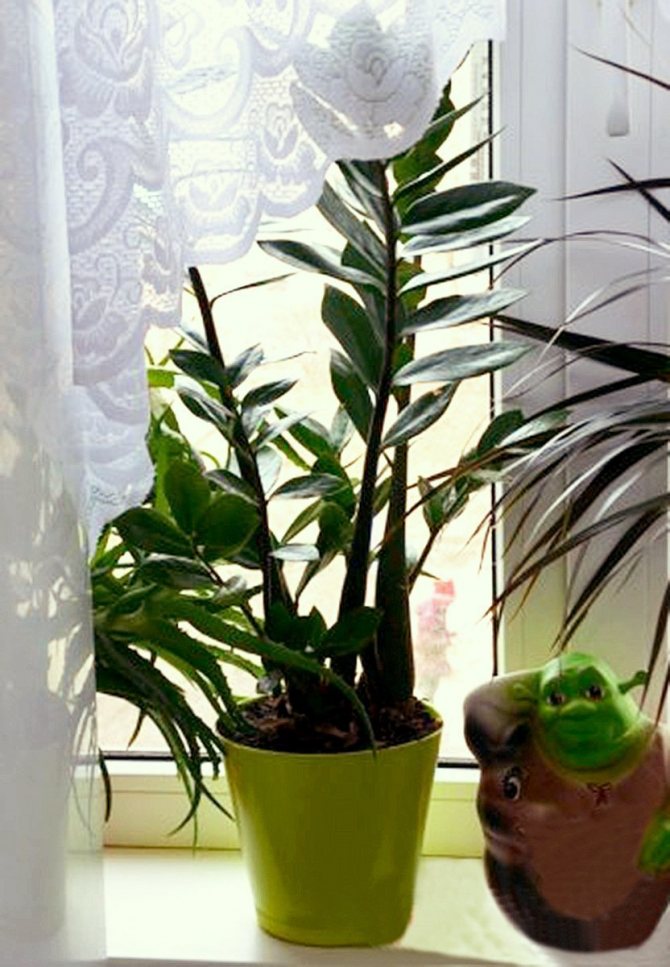

This zamioculcas does not experience a light deficit, which means that etiolation does not threaten it.
Table: Impact of Nutrient Deficiency on Plant Appearance
| External manifestation | Problem |
| Inhibition of leaf growth | Lack of nitrogen |
| Growth slows down, the plant turns pale | Fluoride deficiency |
| Poor root development | Low calcium |
| Development has stopped | Possibly deficient in copper, boron, chlorine or iodine |
Mineral feeding will solve the problem of lack of nutrients. Choose a complex for the plant that will contain scarce elements. Fertilizers for cacti and succulents are usually suitable for zamiokulkas.
When rot appears
Zamiokulkas tuber, its thick petioles are a storehouse for nutrients and moisture. In such a favorable environment, harmful microorganisms multiply with pleasure: fungi, bacteria and viruses. Zamiokulkas tuber - delicious food and a comfortable refuge for them. Sometimes the florist himself, out of inexperience, helps uninvited guests to settle in a pot with a plant. Waterlogging of the soil and air, especially in winter, non-observance of the temperature regime, contaminated land - all this contributes to the spread of various types of rot, the most dangerous diseases of zamioculcas.
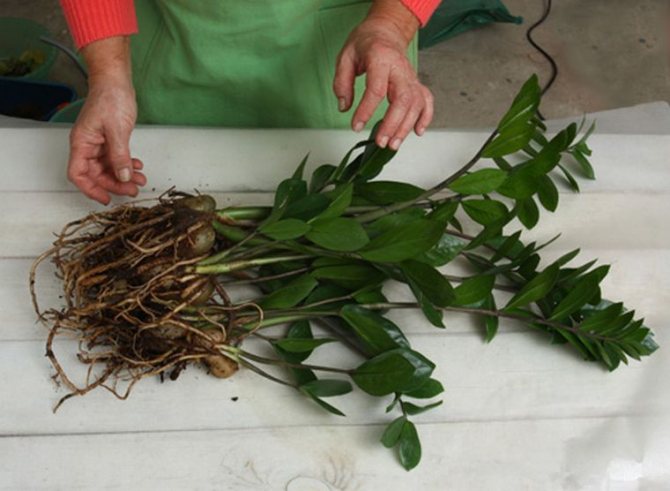

A healthy plant has green leaves and light brown tough potato tubers
Table: varieties of rot, methods of struggle, prevention
| Rot type | Symptoms | Treatment | Prophylaxis |
| Dry rot, or phomosis. Insidious asymptomatic course | The plant at first turns pale, then dries out from the inside. The disease is fleeting. | The disease is detected too late, when it is already useless to take any measures. A plant infected with dry rot will inevitably die. | To prevent phomosis, periodically spray or water zamioculcas with a solution of systemic fungicides, for example, Maxim. |
| Rot of the stems (leaves) is provoked by heavy clay soil, which does not provide air and water permeability, excessive watering at low temperatures, injuries, and an associated bacterial infection causes illness | A wet brown plaque appears on the petioles of the zamiokulkas, the tissues soften and die | This is the most common cause of the death of a flower; you can try to save it by digging out the tuber and removing the affected parts, sprinkling the cuts with crushed coal.The entire plant, both above and below ground, is treated with a systemic fungicide (Oxyhom, Fundazol) and planted in a new pot, completely replacing the substrate. If the process has gone too far, the affected tuber is thrown away, the remaining parts of the leaves are used for reproduction. | Heal all injuries on the plant, observe the care regimen, be sure to keep new acquisitions in quarantine |
| Root (tuber) rot occurs at low temperatures, systematic waterlogging of the soil and stagnant water | Zamioculcas, affected by root rot, if you do not take action, turns yellow, withers and dies. The cause of the disease can only be seen by taking the plant out of the pot. | If a small part of the tuber is affected by rot:
If the putrefactive process has affected almost the entire tuber, it will have to be thrown away, try to root healthy leaves | Observe the main rule of watering zamiokulkas: moderation and again moderation. Maintain normal temperature conditions |
Dealing with soot, brown and rusty stains
The mob is a disease caused by a fungus that eats the secretions of aphids or mealybugs. The leaves are covered with a black sooty bloom, it is not too dangerous for the plant, but it prevents it from breathing, isolates it from light. Because of this, leaf growth slows down, the plant weakens. Remove deposits with a damp cloth. Then wash the entire plant. Prevention of the mob is a timely fight against insect pests.
Zamioculcas, like other succulents, can infect spots of various origins. They are caused by fungi, viruses, bacteria. Plants with weakened immunity are susceptible to this disease. Stains can appear due to cold drafts, temperature changes or high humidity.
A sign of brown spot is the formation of dry, depressed brown spots on the petioles and leaf plates. They can increase in size, or they can remain unchanged. If the disease progresses, action must be taken. They fight spotting with the same methods as with rot. Cut out damaged leaves, treat the cuts with charcoal and cinnamon, and spray the fungicide with zamiokulkas.
Rust is a type of spotting. The plant becomes covered with rusty crusts or streaks. One of the reasons is care errors: burns, injuries from droplets of cold water hitting the leaf, a sharp drop in temperature. A fungus enters the injured area and provokes the appearance of rust in other places. Removing crusts and rust stains is not recommended. In their places, the tissue is ugly scarred. Fungicide treatment helps to curb the growth of spotting.
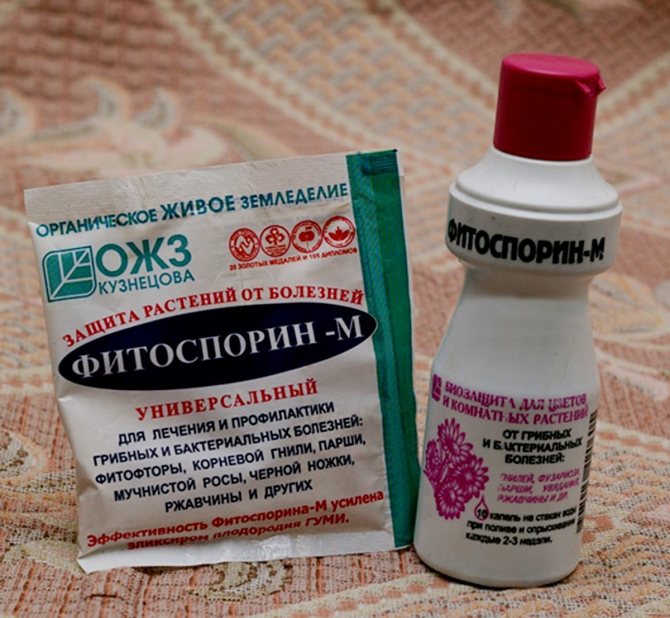

Fitosporin works well in the early stages of rust disease
Sometimes "self-healing" happens: mushrooms do not tolerate the combination of dry air and light, and when the zamiokulkas is placed in a very bright, dry place, the spots stop growing.
Photo gallery: putrefactive and other diseases of zamioculcas
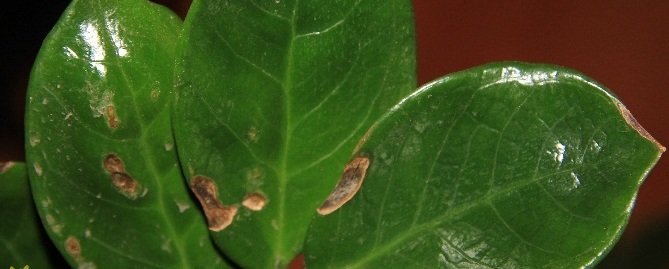

Brownish dry spots appear on the leaves or stems - this is a brown spot
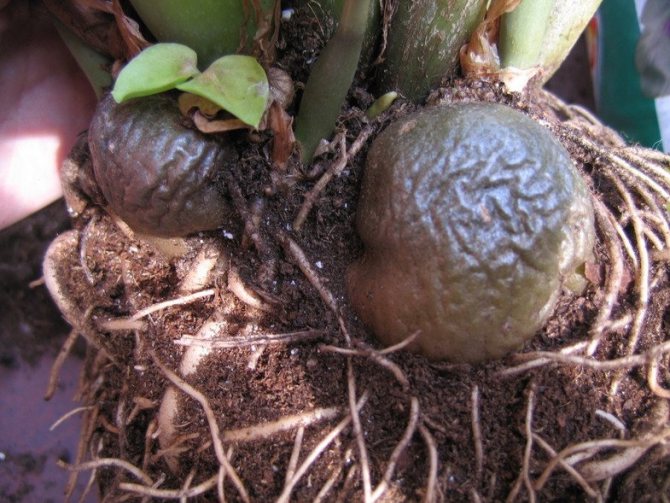

Root (tuber) rot is the most common disease of zamiokulkas
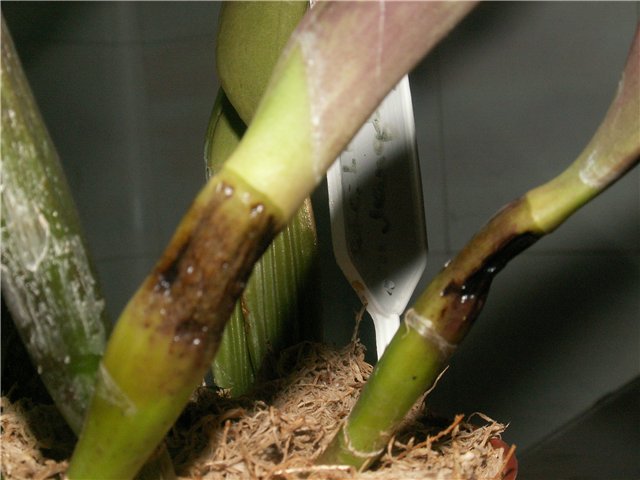

Rot of the stems is caused by a bacterial infection, and excessive moisture provokes the disease


Rust is a consequence of maintenance errors


A plant infected with dry rot (phomosis) dies
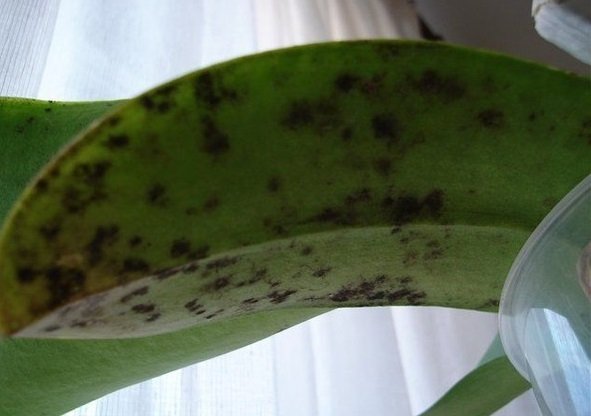

Mobile is a fungal disease that occurs on plants infected with pests


With chlorosis, the process of photosynthesis is disrupted, the leaves are covered with white and yellowish spots.
Fungicides for the treatment of leaves, trunk, tubers, roots
- Fundazole destroys pathogens of various diseases. Stems and roots are sprayed with a weak solution of up to 0.1%.
- Sulfur is an effective remedy for treating fungal diseases and killing ticks. It is more convenient to use in the form of a powder, dusting the plants.
- Quinosol is an antifungal and antibacterial drug. You can buy it at your regular pharmacy. Dissolve the tablet in 10 grams of water. The solution can be moistened with leaves and water the earth. Used for soil disinfection.
- The drug Maxim is used for soil disinfection and treatment: it helps with fusarium, phomosis, and wet rot. A 2–4% solution is prepared from the preparation for watering and processing plants. Valid for approximately 2.5 months.
- Hom (copper oxychloride) is a very effective remedy against brown spot, rust, and various bacteriosis. For 20 grams of powder, take 5 liters of water. They are processed 5-6 times, after two weeks.
- Fitosporin is a drug for protection against fungal and bacterial infections. Helps only at the initial stage of the disease. Can be used for prophylaxis. A small amount of Fitosporin paste (from the tip of a knife) is diluted in a teaspoon of water, 5 drops of the solution are dripped into a glass and the substrate is watered or the plant is treated.
Video: prevent zamiokulkas, which has begun to turn yellow, to rot
Drought
Another reason for the yellowing of zamiokulkas leaves. It arises from excessive awareness and blind adherence to stereotypes. The owners know very well that they are growing a succulent. And they completely stop worrying about regular watering. The African visitor understands that these are difficult times and it is time to activate the water-saving system. That is, it drops the entire above-ground part. Maybe it will grow back later when the rainy season comes.
Florists panic and frantically looking for the cause of what is happening. But you don't have to go far. If zamioculcas can easily tolerate dry conditions for a long time, this does not mean that it can do without water at all.
Signs.
The leaf plates turn sharply yellow throughout the plant. Then they quickly dry up and die off.
What to do.
Cast your pet immediately! True, you should not immediately settle it in a swamp slurry. For a start, it is enough just to slightly moisten the soil. After a few hours, the procedure is repeated. During this time, thin feeding roots will come to life and begin to work actively.
Excess fertilizer
Zamioculcas is a slow-growing plant that requires small amounts of nutrients. Excessive fertilizing will not only not benefit the growth and development of the crop, but also lead to salinization and compaction of the soil in the pot. This will negatively affect the work of the root system of the flower, possibly the appearance of root rot and the death of the plant in the future. Yellowed leaves that appear may signal such a problem.
The main thing that needs to be done urgently is to transplant the flower into a new substrate by examining and processing the underground part of the culture. It is recommended to apply top dressing in minimal volumes and three times less concentration than recommended in the instructions for the preparation. Fertilizers most suitable for zamioculcas are nutrient mixes for succulents and cacti.
Anti-yellowing measures
Many readers are interested in the question of how to revive a dollar tree if the leaves turn yellow. First of all, you need to find out the reason for what is happening. Only by eliminating it, you can deal with the consequences. We have listed all possible options in our article.
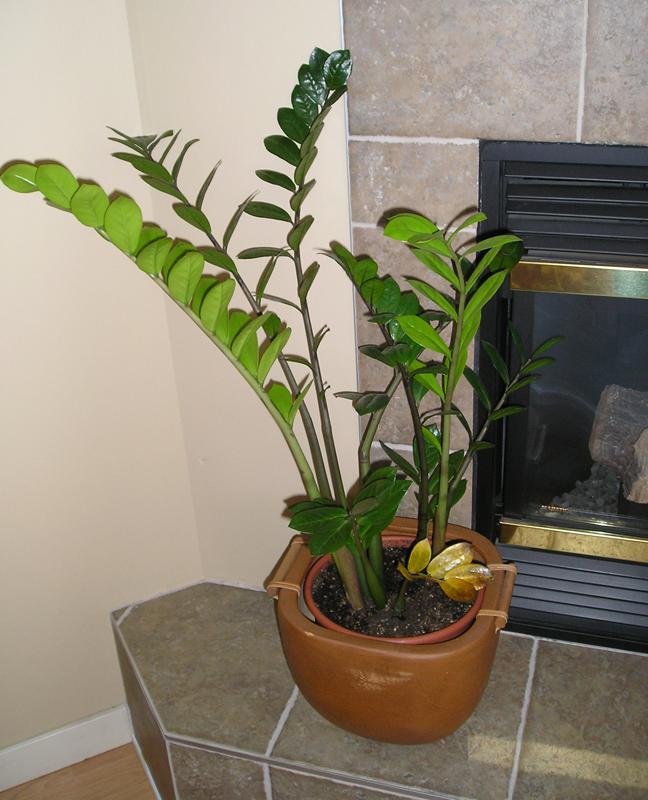

If your plant is attacked by parasites, then you cannot do without special preparations. In all other cases, it is necessary to establish proper care. In case of decay of the roots, a transplant with a complete replacement of the soil is required.
Even if your dollar tree is badly damaged, don't worry. Culture has one very important feature.It can be restored from any surviving part. Therefore, the chances of saving the plant are very high.
Although, if all the recommendations are followed, zamioculcas feels great in any apartment and grows well.
Harmful insects are the hardest to deal with. At first, when there are still few of them, the bushes can be treated with soapy water. If a lot of pests have already bred, you will have to use insecticides. Most often, several treatments are required.
Zamioculcas pests
If the leaves of zamiokulkas turn yellow, the flower can signal a pest attack.
A plant that is brought out into the open air in summer is at risk of aphid infestation on young shoots and back foliage. The insect brings the greatest harm to immature plants.
Therefore, after bringing the pot into the room, it is better to arrange a weekly quarantine for the zamiokulkas, and to identify pests, treat the greens with an insecticide.
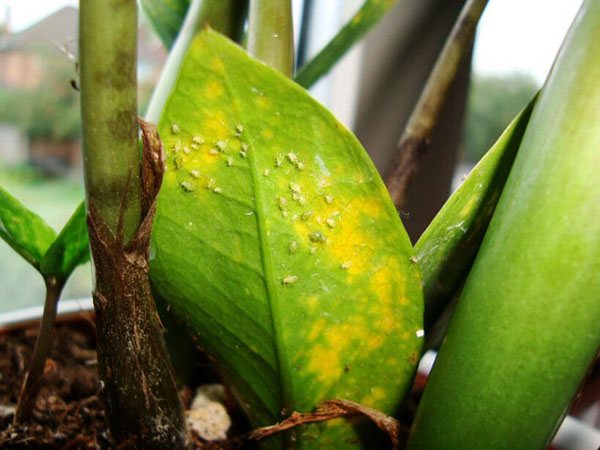

In addition to aphids, culture is threatened by:
- spider mites that quickly spread in dry indoor air;
- scale insects falling on zamioculcas from the street or neighboring plants;
- thrips and mealybugs.
It is not enough to fight spider mites with systemic acaricides. Chemicals will only give a temporary effect if you do not take care of the yellowed zamiokulkas at home.
Systemic insecticides are used against scale insects, thrips and worms, and in relation to the last two pests, it will be necessary to carry out not one, but several treatments.
To avoid an unpleasant spectacle for the grower, when the zamioculcas turns yellow, the leaves of the flower wither and fall off, you can provide the plant with the optimal temperature of maintenance, lighting, watering and feeding. We must not forget about the timely transplantation of decorative culture and careful attention to the selection of the substrate.
Features of caring for zamiokulkase so that the foliage does not turn yellow - video
This guest from Africa has just recently begun his triumphant march through the windowsills of our country. Owners of zamiokulkas often confuse it with an ordinary houseplant, not realizing that a succulent can be just that - with juicy green leaves, without thorns and matt bloom.
Incorrect transplant
The dollar tree loves tight pots. A common mistake of flower growers is to transplant a flower immediately into an oversized pot. The new container should be only 3-4 cm larger than the old one. If it is too voluminous, after a while the roots of the zamiokulkas may begin to rot, and, as a result, the leaves turn yellow and dry.
If after transplantation several leaves turn yellow, there is nothing to worry about. This is the plant's response to stress.
By the way! Read: how to transplant a dollar tree correctly.
Excess and lack of fertilizing
Like any living organism on the planet, zamioculcas needs proper and timely nutrition. Lack of nutrients leads to yellowing of the leaves, loss of appearance and general weakness of the plant.
The dollar tree accepts both organic and mineral fertilizers well. The ideal feeding scheme is to alternate the types of fertilizer.
You can also do it yourself. Professionals advise using sugar water, ground eggshells, yeast, citrus zest and banana peels as fertilizer.
The first time you need to feed the flower is when it is planted in a pot. During the growing season, feeding should be carried out 2 times a month. When buds appear on the flower, feeding must be suspended until next spring.
Frequent fertilization is undesirable and can lead to plant disease.
Zamioculcas grows slowly, so an excess of feeding will only lead to soil clogging and negatively affect the general condition of your pet.
IMPORTANT!
If you "overfeed" the plant, then you need to take the following measures:
- the flower must be removed from the pot;
- thoroughly clean from spoiled soil;
- check the roots of the plant;
- if there are damaged areas, remove them;
- transplant into another pot.
Why does zamioculcas not give new shoots?
The reason that the leaves of zamiokulkas turn yellow, lose their rich green color, or even wither, is often a lack of light. Unfortunately, flower growers forget about the change in illumination in the autumn-winter period.
The pot with zamiokulkas located in the back of the room needs to be rearranged closer to the window, when this is not possible, the culture is provided with additional illumination.
The owner of an ornamental plant complaining that the zamiokulkas does not give new shoots should pay attention to the location of the pot and the quality of the soil in it. Although the plant is not fast-growing, the slowdown in young foliage is often attributed to a nutrient-poor substrate or the need to transplant a green pet. In this case, the root system occupies the entire volume of the pot, leaving no room for soil. Because of this, the flower suffers, the leaves of the zamiokulkas turn yellow, growth stops, and the existing greenery withers.
Signs associated with the Zamioculcas plant
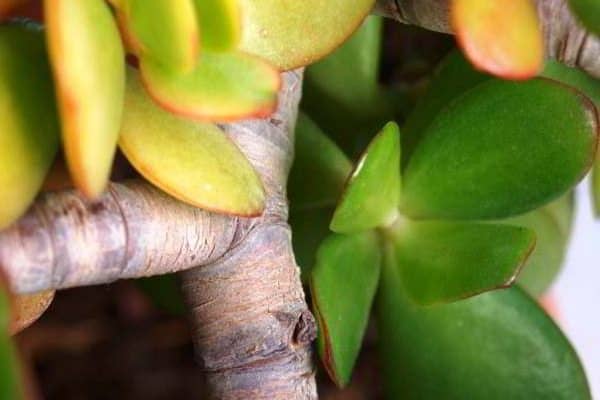

There are many signs around zamiokulkas. The first is that the plant will bring prosperity and well-being. In this case, it is important to provide good conditions for the growth of the flower. If the tree starts to wither, the family faces financial problems. Second, a flower will bring happiness to a woman. The main thing is to try to achieve its flowering. Third, the flower cannot be accepted as a gift. If you are given it as a gift. you need to pay a symbolic amount. Only in this case will the plant bring wealth.

